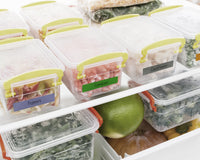
As you get your new restaurant off the ground, you may feel as though you know your way around the kitchen. After all, you’ve already gotten rave reviews from friends who’ve sampled your cuisine. But once business picks up and more people find out about what you’ve got cooking, you won’t have that kitchen all to yourself anymore. Relying on an intuitive grasp of what goes where and when you bought it allow you to keep a handle on things, but that won’t be enough for your growing staff. This means extensive labeling throughout the kitchen must be implemented.
At first, a thorough labeling of all your kitchen supplies may seem superfluous or even a little neurotic. In fact, such a comprehensive approach is not only prudent but necessary to remain in compliance with the FDA. In this guide to how to label food in a restaurant or commercial kitchen, we’ll break down the food-labeling process and make labeling as second nature for you as preparing delicious meals.
Note Time and Temperature Sensitivity
All food products come with expiration dates—however far down the road—and require a baseline of temperature control. Meat and produce, however, call for more precise controls and notation. Your labels should include not only the name of the product, when the food was added, and when it will expire, but also the temperature the product must be kept at. Keeping items at the wrong temperature or allowing them to expire before use could have disastrous ramifications for your restaurant.
“I Don’t Care If Monday’s Blue…”
Have you noticed that the twist ties on loaves of bread come in different colors? These colors denote the days of the week bakers baked the loaves. Bringing color-coding principles into your kitchen labeling system will help reduce waste and ensure the freshest possible products. Color-coded food rotation labels include the type of food in the container, the acquisition date, and the expiration date, along with a color denoting which day of the week they were added. Using color-coded adhesive tape will help workers immediately make the connection—for instance, blue indicates a product was added on Monday, yellow on Tuesday, and so forth.
Label and Sort Properly
Cross-contamination is a scourge of commercial kitchens. With so many allergies in the population and the dangerous nature of raw meat, keeping items properly partitioned is important. Preventing cross-contamination is one of the best reasons to label food in a restaurant or commercial kitchen. Clearly labeling produce, meat, and poultry will help employees keep them apart in the kitchen so that, for instance, raw chicken won’t come in contact with your lettuce. Fill out your labels clearly in cases where employees cannot merely eyeball the contents and organize your items well.






